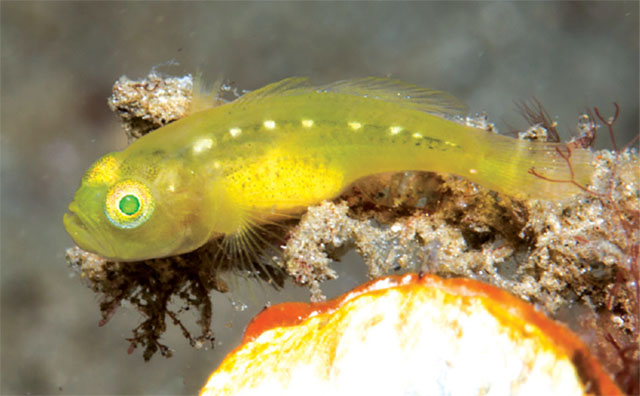| Gobiidae (Gobies), subfamily: Gobiinae |
| 1.09 cm SL (male/unsexed); 1.15 cm SL (female) |
|
benthopelagic; marine; depth range 20 - 30 m |
| Western Pacific: Papua New Guinea. |
|
Dorsal spines (total): 7-7; Dorsal soft rays (total): 9-10; Anal spines: 1-1; Anal soft rays: 6-7; Vertebrae: 24-24. This species is distinguished by the following characters: D VI-I,9-10 (rarely 10); A I,6-7; pectoral-fin rays 17-19 (rarely 17 or 19); both the anterior and posterior nostrils are present; no scales; pelvic disc with conspicuous frenum; greatest body depth 3.1-3.7 in SL; head length 2.7-3.2 in SL; head compressed, its width 1.0-1.3 in head depth; caudal fin is rounded, 2.6-3.5 in SL. Colouration: in life either semi-translucent dull yellowish or semi-translucent whitish, both varieties with pigment along vertebral column, as alternating long, dark, dash-like marks with intervening shorter white sections; head and body are covered in a uniform scattering of fine melanophores (Ref. 111062). |
| Apparently invariably associated with a (Polycarpa sp.) on silty-sand bottoms. which was common between about 13-30 m, but only populated by fishes below a depth of about 20 m. About a third of the tunicates below 20 m were estimated to be occupied by fish, solitary or in pairs. The fish were usually observed perched on the lip of the tunicate’s oral or incurrent siphon, retreating quickly inside when disturbed and also made brief forays on the exterior part of the tunicate and around its base (Ref. 111062). |
|
Not Evaluated (N.E.) Ref. (130435)
|
| harmless |
|
Source and more info: www.fishbase.org. For personal, classroom, and other internal use only. Not for publication.

